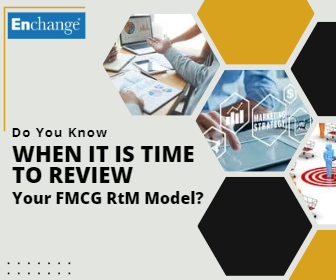What is a Route to Market Model (RtM)?
An RtM model is a set of commercial capabilities that focus on how to get goods/services to target customers effectively.
It must encompass the following:
- Trade Coverage - Maximise availability in target channels/outlets.
- Excellence in Execution - Superior in-store presence and brand activation at the Point of Sale (POS).
- Customer Experience - Delighting retailers and partners
An effective RtM model will deliver growing sales, share, and profitability.
But, even if we have done everything right, and we have the correct formula in place, we are always operating in an ever-changing environment.
So that throws up one very important question, when do we review our RtM Model?

This could be a very long list. You may need to review the RtM Model if the company has been taken over, if there is a new competitive threat, if there is a new company direction, a massive technology change, etc.
The point is, there are 'trigger factors' that we need to recognise, to enable an RtM Model review.
Let's focus on six common 'trigger factors' for an RtM Model review, and what they each entail.
- New Market Entry - Before any market entry, we need to conduct market mapping and analysis to fully understand the market (channel structure, channel size, store universe, competitors…), we also need to study all available RtM models in the market. Based on the analysis/study, we then decide on the channel and geographic priorities and select the optimum RtM model.
- New Segment/Category Entry - When we enter into a new segment or category, we don’t have the same strengths as we have in the current segment, therefore what works well in the current segment may not work in the new segment. An RtM model review will help us to avoid very common mistakes, such as the “one-size-fits-all” approach.
- Market Share Drop - A market share drop can occur for a number of reasons. It can be a significant share drop from a particular channel/city, an offtake issue, or a sales fundamental issue (distribution, visibility, conversion at POS). If it’s a sales fundamental issue, then it will have implications on the RtM model such as increasing our direct influence on demand creation tasks, perhaps switching to a Hybrid or even a Direct RtM Model, and thus reducing dependence on Wholesalers and Distributors. However, no matter which option may seem appropriate, we need to review the RtM model in this scenario.
- Growth Acceleration - When growth acceleration becomes the #1 priority, we need to review and adjust our RtM model to ensure that we have the right level of direct influence on demand creation tasks. POS control must be prioritised over cost efficiency. Trade coverage and speed to market become crucial. Our current RtM setup, may not deliver these key components.
- Bottom Line Pressure - When bottom line improvement is the priority, we need to review our RtM model to identify saving opportunities. Adjusting the RtM model in favour of cost efficiency and accepting a lower level of POS control. When adjusting the RtM model, our brand strength decides how far we can stretch for cost efficiency without damaging the long-term position.
- Substantial Changes in Consumer Behaviour can disrupt channel structure. For example, a switch from out-of-home to in-home consumption or a switch from Traditional Trade to Modern Trade consumption driven by, for example, a young population, may change our channel priority. As a result, our RtM model should be adjusted to accommodate that channel priority change. The covid pandemic is an example of this substantial change.
We have just discussed six potential scenarios. There are many more. What is crucial to understand is the presence of potential 'trigger factors', and the need to react quickly, in a measured and analytical way.
What should you do now?
- Subscribe to my Newsletter on Route to Market Excellence.
- Subscribe to our Route to Market Blog here.
- Take our free distributor management training course here.
- If you need specific help on RtM Training or any RtM issue, please reach out to me
- Use our 20 Steps to Route to Market Excellence model to guide you on your RtM journey.
- You can use the Enchange Supply Chain House to help with your Supply Chain Transformation.
- As we always say, NOW is the time to review, build, and/or transform your RtM Strategy and Execution to reap the rewards. Do not wait. Feel free to use our 20 Steps to Route to Market Excellence Implementation Guide to help you







